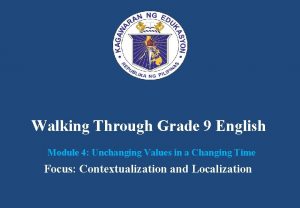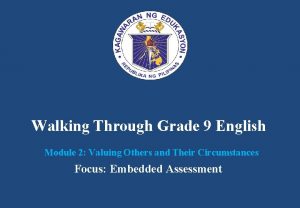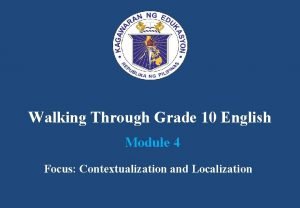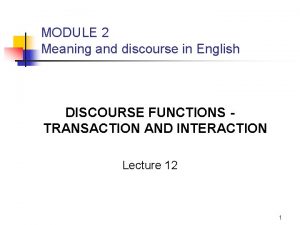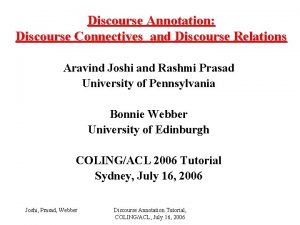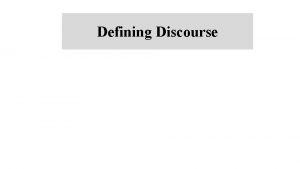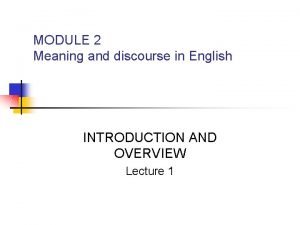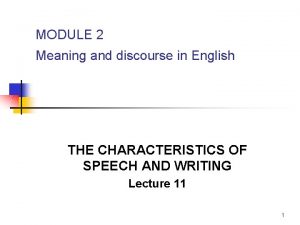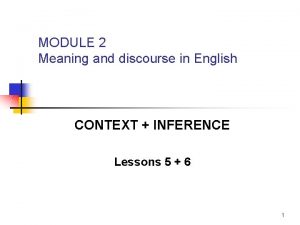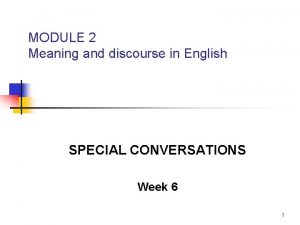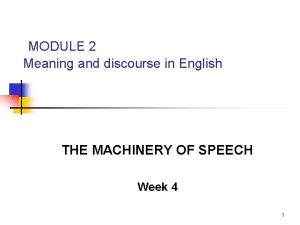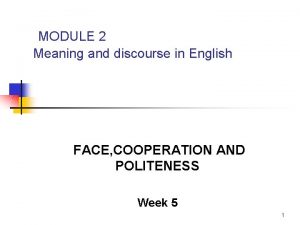MODULE 2 Meaning and discourse in English THE



















- Slides: 19

MODULE 2 Meaning and discourse in English THE MACHINERY OF SPEECH Lesson 13 1

Conversation analysis (1) n n n Turn taking Repair Adjacency pairs Insertion sequences Preferred and dispreferred responses 2

Turn taking n n Conversation is analysed in turns. One speaker and then the next A turn consists of one or more turn constructional units The end of a turn constructional unit is a point during a turn when another speaker can intervene This point is called a turn transitional relevant point 3

An example R. so um phoebe tells me you er play piano M. yeah R. you know I used to play keyboards in college M. why do you have one here? R. no M. OK n n n Each of these speeches is a turn. There are 6 TCU’s and 6 turns The other speaker intervenes regularly at each TTRP 4

How turn-taking works 3 possibilities n The current speaker selects the next speaker OR if this does not operate n The next speaker self-selects OR if this does not operate n The current speaker may continue 5

You need to be able to look at a dialogue and work out what is happening in it with regard to turn-taking So learn the rules of turn-taking and practice using them to analyse conversations 6

An example R. so um phoebe tells me you er play piano M. yeah R. you know I used to play keyboards in college M. why do you have one here? R. no M. OK n n n R self-selects R selects M M selects R M self-selects 7

Repair n n n Repair is needed when the turn taking rules are failing to operate Simultaneous speech often needs repair when two people are speaking at once Silence needs repair because no one is talking. Who repairs the silences in the conversation between Miss A and Mr B and between Mikey and Ross ? 8

Adjacency pairs n Conversation is often structured around pairs of utterances that are dependent on each other. : n n n “good morning” “what’s the time? ” “ 3 o’clock” These are called adjacency pairs 9

Breaking adjacency pairs n If you break an adjacency pair (e. g. not answering a question, answering “hello” with “goodbye” you are causing “trouble” in the conversation which needs to be repaired. 10

Insertion sequences n n These are sequences which are inserted inside adjacency pairs The topic of the insertion is usually related to the first part of the adjacency pair 11

An example Turn 1 Turn 2 Turn 3 Turn 4 Shall I wear the blue shoes? You’ve got the black ones They’re not comfortable Yeah, they’re the best then, wear the blue ones Turns 2 and 3 are an insertion sequence and the adjacency pair is completed in turn 4 12

Preferred and dispreferred responses n n A preferred response is acceptance and is usually short, without hesitation or elaboration A dispreferred response is refusal and is usually performed hesitantly and elaborately 13

An example n n n D: I was thinking we could have fish J: Fine A: well actually I’ve stopped eating fish now because of you know the damage it does to the ocean J’s response is a preferred response; it is short and not hesitant A’s response is a dispreferred response; it is 14 hesitant and elaborate

Can you analyse the responses of Ross and Mikey in terms of preferred and dispreferred responses? Which is not an appropriate response? 15

Discourse markers (markers of interaction n n They can signal to the listener that the speaker wishes to continue speaking The can signal to the listener where the conversation is going compared to where it has been before 16

An example - “well” n “well actually I’ve stopped eating fish” - “well” is sometimes used at the start of a turn to signal that the speaker wishes to continue speaking (filler) - it is also used to indicate that the speaker is about to say something that is in conflict with what the previous speaker has just said - or it can be used in both ways at the same time 17

RS-S R. so um phoebe tells me you er play piano RSM M. Yeah RS-S R. you know I used to play keyboards in college? RSM M. why do you have one here? MSR R. No MS-S M. OK RS-S R: um er you know I’m divorced er Phoebe 18

Selection in Friends R selects M it M: yeah I I’m sorry I don’t really like to talk about R self-selects R: oh that’s OK we’ll talk about somethin’ else M self-selects M: So you … you’re a palentologist right and M selects R R: yeh M self-selects M: my cousin’s a paleontologist R self-selects R: ha? and R selects M M: (nods) R self-selects R: well he and I would probably have a lot to talk about 19
 What is discourse
What is discourse C device module module 1
C device module module 1 Grade 10 english module 4 pre test answer key
Grade 10 english module 4 pre test answer key Grade 9 pre assessment answer key
Grade 9 pre assessment answer key Nishtha module 8 answers
Nishtha module 8 answers Achieving through english
Achieving through english Example of contextualization and localization
Example of contextualization and localization Words worth english language lab
Words worth english language lab English module grade 10 unit 3
English module grade 10 unit 3 Hát kết hợp bộ gõ cơ thể
Hát kết hợp bộ gõ cơ thể Lp html
Lp html Bổ thể
Bổ thể Tỉ lệ cơ thể trẻ em
Tỉ lệ cơ thể trẻ em Chó sói
Chó sói Tư thế worm breton là gì
Tư thế worm breton là gì Chúa yêu trần thế
Chúa yêu trần thế Môn thể thao bắt đầu bằng chữ đua
Môn thể thao bắt đầu bằng chữ đua Thế nào là hệ số cao nhất
Thế nào là hệ số cao nhất Các châu lục và đại dương trên thế giới
Các châu lục và đại dương trên thế giới Công của trọng lực
Công của trọng lực


